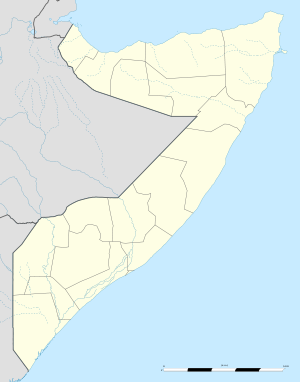- Hobyo
-
Hobyo Location in Somalia Coordinates: 5°21′N 48°32′E / 5.35°N 48.533°E Country  Somalia
SomaliaRegion Mudug District Population - Total 12,000 Time zone East Africa Time (UTC+3) Hobyo (also spelled Obbia and Hobyaa) is an ancient harbor city in the Mudug region of Somalia. Hobyo literally means "here, water", and the plentiful fresh water to be had from the wells in and around the town (a rarity in this part of the world) has been the driving force behind Hobyo's ancient status as a favorite port-of-call for sailors.
Contents
Establishment
Hobyo's history began as a place for sailors and caravans to get fresh water, thus its name. It only became a town of importance when the Muslim pilgrims departing for Mecca on their Hajj and the sea captains who would take them there began favoring the town as a point of departure because of its fresh water. This sea and land traffic soon led to Hobyo becoming something of a commercial center. Opone, the once-great entrepot, which had been the center of commerce, began its decline into obscurity.
The increasing importance and rapid settlement of more southernly cities such as Mogadishu further boosted the prosperity of Hobyo, as more and more ships made their way down the Somali coast and stopped in Hobyo to trade and replenish their water.
Middle Ages
Hobyo was the commercial centre of the Ajuuraan State, based in Qalafo (located in the present-day Ogaden). Commercial goods harvested along the Shabelle River (especially around the agricultural centers of Harardheere and El-Dheer) were brought to Hobyo for trade. The Ajuuraan rulers collected their tribute from the town in the form of sorghum (durra).
Hobyo's Ajuuraan rulers were allies with and occasionally overlords of the Mogadishu Sultanate, and trade between Hobyo and the Benadir coast flourished for some time. So vital was Hobyo to the prosperity of the Ajuuraan State that when the Hiraab (a lineage of closely related Hawiye clans) successfully revolted against the Ajuuraan and established an independent Hiraab Imamate, which included Hobyo, the Ajuran's might dwindled rapidly. The Ajuuraan State remained in its power base in Qalafo, but was a shadow of its former self.
Sultanate of Hobyo
A Majerteen pretender to the throne, Yusuf Ali Keenadid, who had been exiled to the Arabian Peninsula by Boqor Isman Mahamud after a failed coup d'etat, returned from Arabia and invaded Hobyo in 1878 with an army of mercenaries from the Hadhramaut. After conquering Hobyo from the local Hawiye clans, Sultan Keenadid established himself as the ruler of the newly-created Sultanate of Hobyo.[1]
The people in and around Hobyo grew mainly sorghum and beans as their staple foods, supplementing this with herds of camels, cattle, goats and sheep. Livestock, hides and skin, aromatic woods and raisins were the primary exports, while rice, other foodstuffs and clothes were imported. Merchants looking for exotic goods came to Hobyo to buy textiles, precious metals and pearls.
Present-day
With the defeat of the Sultanate of Hobyo at the hands of Fascist Italy 50 years later, Hobyo was annexed into Italian East Africa.
After its annexation by Italy, Hobyo's lifeblood, the trade routes that had passed through the town for 10 centuries, moved permanently south to Mogadishu. The town never recovered its former prosperity. The majority of the populace, who had been involved in said mercantile activities, followed the trade down to Mogadishu, establishing the link between these cities that has existed to this day, and the town has played no major role in any of the ensuing conflicts with Ethiopia either as part of Italian East Africa or independent Somalia. The governments of both have actively encouraged the town's decline in fact, as they increasingly centralized Hobyo's historical roles within Mogadishu. Hobyo is a shadow of its former importance and wealth.
Hobyo was captured by the Islamic Court Union (ICU) on August 16, 2006, after several days negotiation with leading figures in the town. ICU armed pickup trucks ("technicals") surrounded the town several days before, and sent in delegates to negotiate Hobyo's surrender. The city was apparently taken without firing a shot, as the unnamed warlord of Hobyo had fled days earlier upon hearing of the ICU's approach.
Hobyo is also involved in piracy, serving as a location for pirates to anchor hijacked ships, such as the MV Faina, while demanding ransoms.[2]Notable people
- Yaasiin Cismaan Keenadiid (1919-) - writer and intellectual
- Osman Yusuf Keenadiid - inventor of the Osmanya script
- Yusuf Ali Kenadid - founder of the Sultanate of Hobyo
See also
References
- ^ Helen Chapin Metz, Somalia: a country study, (The Division: 1993), p.10.
- ^ "US destroyer nears Somali pirates". BBC News. September 28, 2008. http://news.bbc.co.uk/2/hi/africa/7640496.stm. Retrieved 2008-09-28.
Categories:- Populated places in Somalia
- History of Africa
- History of Somalia
- Piracy in Somalia
- Populated coastal places in Somalia
Wikimedia Foundation. 2010.

